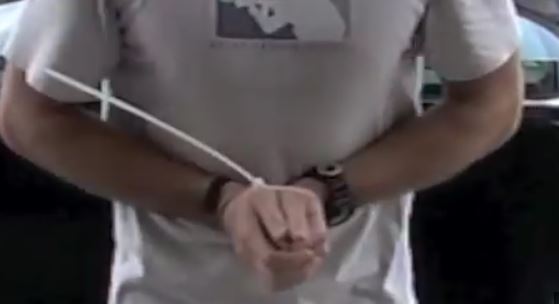More and more, for temporary restraint, zip ties are becoming a popular option.
By understanding how zip ties work and controlling your situation, from a passive posture, you give yourself the best chance possible at defeating the restraint and gaining your freedom.
There are two things you’ll need in any escape situation, and without these two things, nothing we’ll show you will work.
Those two things are time and opportunity.
How Zip Ties Work
Zip ties consist of a sturdy Nylon tape that contains small teeth running lengthwise down one side, and a ratchet with small teeth housed in a small open case.
The ratchet is molded to allow downward pressure to be placed upon it as the tape is threaded through the open case, then springing back up to position as the valleys of the tape align with the teeth of the ratchet, locking the zip tie.
To defeat zip ties, you can either break the zip ties, shim them, or with a little forward thinking just be able to slip right out of them.
Hand Positions
For an exercise, so that we’re all on the same page, put both of your hands straight out. Now touch your wrists together. This will be called “wrists together, horizontal.”
Next rotate your wrists so your right hand turns clockwise, your left hand turns counterclockwise and your wrists touch. This will be called “wrists together, vertical.”
Now, from the “wrists together, vertical” position, rotate your hands so the backs of them touch together.
This will be called “wrists together, inboard.”
The final way you could be bound is by crossing your hands at the wrists, making an X. This will be called “wrists together, crossed.”
Passive Victim
The first thing you should always do in any restraint situation, is remain passive.
Let your captor know that there’s no fight in you, that you’re scared and helpless.
You want to make every effort to present your hands to your captor before they use force to restrain you.
Understanding how zip ties work and how you can position yourself in the best possible way to gain your freedom is a critical set of skills everyone should master.
As with most situations, the process of escaping a zip tie restraint starts before you are even restrained and is mostly mental calculation.
Special thanks to the folks at Its Tactical for these tips as well for the video below, which shows specific tactics to escape the most common type of zip tie restraining method.

Can you show it when hands are bound from the back?
If there behind your back, id imagine you have to at least get your hands to the top of your foot
This really important to know!!!!!
I like that. @[100001611683950:2048:Johnny Weeks] @[100001239073520:2048:Diego Guimarães Pedro]
Yep I saw that before.. find one on handcuffs now 😉 lol
If i have a bobby pin r paper chip I’m free. Not only that i have a key.
That’s fine in front of you but try it behind your back. it is easier too control you with your hands behind your back, and that is how they will bind you.
I would love to see them try that behind there backs,I bet it don’t work that way!
Normally it’s a double cuff
This is stupid.
Neat but, People don’t tend to bind in the front though.
Shoot’m first and you won’t get zip tied..
Glad to see u can get out of cheap zip ties. Now try these!
lets hope the people restraining you are not the cops the cops use the one in the picture of the people restraining you usually are idiots
Incorrectly applied
Palms OUT
Hands BEHIND back
And if you really don’t want them to get loose double up and cuff ’em at the elbows
Interestiong.
Everyone needs ro realize these are not the zip ties the military or police use. They have a metal peice instead of plastic and you can’t snap them